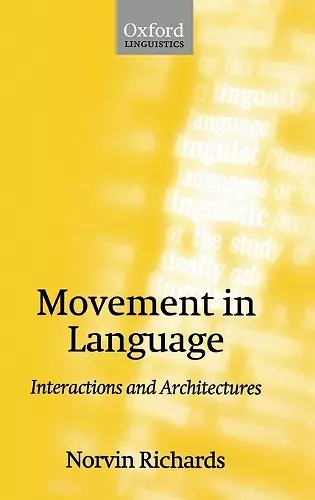Movement in Language
Interactions and Architectures
Format:Hardback
Publisher:Oxford University Press
Published:25th Oct '01
Currently unavailable, and unfortunately no date known when it will be back

This book is the most comprehensive, integrated explanatory account yet published of the properties of question formations and their variation across languages. It makes an important contribution to the current debate over whether syntax should be understood derivationally, arguing that the best model of language is one in which sentences are constructed in a series of operations that precede or follow each other in time. The central problem it addresses is the nature of the difference between (a) languages in which all wh-words move overtly to a clause-initial position (exemplified by Bulgarian); (b) languages in which one wh-phrase moves per clause but all others remain in situ (exemplified by English); and (c) languages in which there is no overt movement at all (exemplified by Japanese). Professor Richards focuses on the nature of syntactic movement in order to see what this reveals about the syntactic derivation. He considers the nature of interactions between movement operations and investigates the behaviour of multiple overt wh-movement, scrambling, cliticization, and object shift. His general conclusions about the relationship between movement and multiple specifiers follow straightforwardly from basic principles of Shortest Move and Shortest Attract. He develops a PF-imposed well-formedness condition on movement chains (essentially, a requirement that a single member of the chain be unambiguously identified as the copy to be pronounced), which allows for the development of theories of anti-agreement, the that-trace effect, and the conditions on participial agreement in Romance, among other phenomena. He defends the claim that well-formed dependencies can improve the status of ill-formed dependencies created later in the derivation, illustrating the explanatory power, under certain structural conditions, of his Principle of Minimal Compliance. He uses data on the locality of wh-movement to argue that the Principle of Minimal Compliance is responsible for a number of the apparent distinctions between overt and covert movement. This book will interest syntacticians at graduate level and above as well as linguistic theorists concerned with the syntax-semantics interface.
... strongly recommend[ed] to anybody interested in the theory of wh-movement and its variation across languages. Journal of Linguistics While there are some inspiring ideas that require further development and some concrete analyses to be worked out in detail, this book surely sheds new light on the crosslinguistic variation in wh-movement, interactions of multiple applications of wh-movement, and well-formedness conditions on movement chains. It touches upon numerous theoretically important issues which should attract much attention and it also comes to grips with various phenomena from a wide range of languages, some of which have received little attention in the literature. Journal of Linguistics The most innovative and striking part of this book is the analysis proposed for the ordering of elements moved to multiple specifiers, which is determined by the notions of feature-based cyclicity and of Shortest. Journal of Linguistics ... the attempt to broaden the scope of investigation to handle a wide range of facts drawn from a variety of languages, and to give them a fairly detailed explanatory account within the minimalist program, makes this book a valuable contribution to the study of syntactic theory. Journal of Linguistics ... certainly one of the most important book-length contributions to minimalist syntax of the last years. It provides fresh insights into the nature of the shortest move / minimal link condition. The Principle of Minimal Compliance represents an original, stimulating way of dealing with the fact that syntactic constraints may fail to be respected by certain dependencies within a clause. And MiL offers an elegant theory of the distinction between overt and covert movement.
ISBN: 9780198241171
Dimensions: 242mm x 163mm x 23mm
Weight: 637g
344 pages